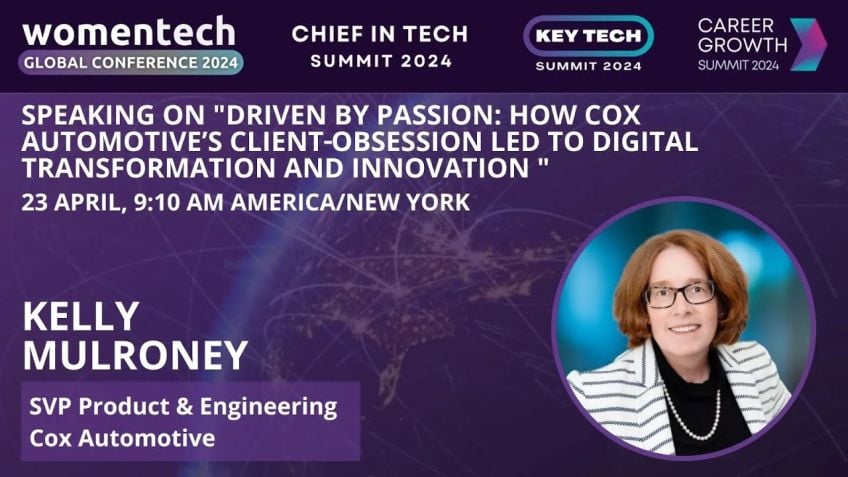Cloud myths and the new normal
Unraveling the Common Cloud Myths
Hello everyone. I'm your guide for this blog post, Sylvia Bellucci and I'm excited you're here. In this piece, I'll be debunking some common misconceptions about the cloud and how it shapes our digital transformation journey. We'll also examine how digital transformation and the cloud influence our current global situation.
About Me
I recently made a challenging yet rewarding transition from IBM to Google after 25 years. A change is as good as a rest, so it's important to embrace change occasionally. I also run marathons, 10km races particularly, a beautiful test of endurance, preparation, and a touch of madness. My joy multiplies when I see my three children who inspire me daily.
What’s the Cloud About?
When we started talking about the cloud years ago, the best analogy that came up likened it to money in the bank; you don't know where precisely it's stored but trust that it's secure and available whenever needed. Similarly, the cloud avails resources on-demand aligned with scalability.
The cloud transformation era has significantly evolved from basic infrastructures, via virtualization, to our present cloud-based layouts. The cloud provides scalability, on-demand availability, and insightful data for your business. However, to realize the power of the cloud, a re-thinking of your traditional business systems is essential.
The Journey to the Cloud
Everyone acknowledges that transitioning to the cloud has myriad benefits from agility to efficiency, scalability, and security. However, we must also address the prevailing myths that hinder companies from moving to the cloud.
Myth 1: Cloud Reduces Costs
Rather than focus on the Return on Investment (ROI), we should shift our attention to the Return on Innovation (ROI). When you factor in innovation, the cloud becomes a resourceful pool for developing new projects expediently, failing fast, and pivoting sooner.
Myth 2: Cloud Isn’t Secure
Now, this is a common fear among companies. However, cloud service providers hire top-notch cybersecurity talents and have put controls and procedures to keep their environment secure. What companies should focus on is internally building robust security structures to protect data and applications in the cloud.
Myth 3: One Size Fits All
Transitioning to the cloud isn’t a one-size-fits-all journey. Companies can choose multiple routes to get to the cloud. The important thing focuses on reaching your business's digital transformation objectives. So, it’s essential to understand your applications and architecture and select the most fitting technology to meet your business goals.
The Post-pandemic Digital Transformation
Last year, we learned some hard lessons as the pandemic hit. The new normal requires a deeper understanding of how technology can serve us. As such, there's a need to gear everything in line with our digital landscape. Hence, the need to either post any questions in the Q&A or reach out via chat.
Remember, the cloud can have its disadvantages, especially if you decide to move everything to the cloud, a process that can be costly and time-consuming. It’s critical to decide what to move to the cloud carefully.
Feel free to reach out for further guidance on this journey. I'm available on Twitter and LinkedIn. Enjoy your cloud journey!
Video Transcription
Good morning and welcome to this session. I'm glad you uh to be here and glad you, you joined this session. I am Sylvia Bellucci and uh I in the next 20 minutes, I'll guide you through um some of the common cloud myth um how preventing our digital transformation.And we will take a look at how cloud and digital transformation are impacting uh the period that we are experienced, you know, the pandemic and very tough period where we are we are experiencing. So what we will be talking in the next 20 minutes, I will present myself, then we will talk about cloud and what it's all about. We will review the three key myths around cloud and we um briefly uh look at the lesson that pandemic is giving us. So let's make this um meeting interactive. I mean, this talk interactive. So whenever you have any, any questions, please uh use the chat and uh otherwise we can leave the fi the last five minutes um for our Q and A. OK. So this is me uh after 25 years in IBM, I moved to Google uh recently it was a big change for me, very challenging, very impactful, you know, I left the people the job, the things I knew. And I, I started this new adventure. It, it has been a very uh big change for me and I wanted to share, to share with you. Um So far, so good. So I'm happy about the change, you know, change is part of our life.
So, um it's important uh uh whenever you can to change and to, to move things around to, to be sure that you, you, you, you are, you are still alive and you, you are ready for new challenges. Uh The third picture, you see me uh uh about to run a 10 kilometers uh race. You know, I am a mm a runner or at least I pretend to be a runner. Um I don't know if you have made such experience uh running a marathon uh requires determination, uh preparation and a bit of madness that uh can give you a lot. I know around five marathons in my life, they've been so different. One from each other. They have learned me many, many things. I'm really happy to, to run. And uh then you can see my three kids uh picture was taken a couple of years ago, you know, they are giving, they are giving meaning to my, to my life. So I'm happy, happy mother. I also have an husband but I didn't put his, his picture here. OK. So let's dig into our topic. What cloud is all about this quick, uh, talk is not, um, aiming to give you a lesson around cloud because I, I'm sure you, you know about it. I want just to give you one of, I think is the best analogy I've heard many, many years ago, the first years we were starting talking about cloud. You know, cloud is like money.
When you give money to the bank, you don't know exactly where they store it, you don't know it, you know that they are securing it. But the most key important thing is that whenever you need it because you have to take it from an ATM or you are making a payment, you want the money to be there. So this is I think the best analogy and whenever you need more, you need to to have a way to get more money. OK? This is where the analogy is not that good, but let's let's let's keep it for good. So Cloud is the capability of getting resources on demand whenever you need it with um great scalability and possibility to um to use them where it makes more sense. So we are living in this uh transformation cloud era, we started with infrastructure, then we moved to virtualization and now everybody's talking about cloud. So cloud gives you a lot of things we talked about scalability on demand availability with cloud. You can give your people real insights about what they are doing, they are you can give real insights in their hand with cloud. You keep data and application where it makes more sense. OK. But where are we starting from? What is our starting point?
Because remember cloud is not a target cloud is a journey. The key point here is provide people customers with means to succeed in the market. It is their life and cloud is just instrumental to this journey. So where we are starting from, we are starting from strain stuff, legacy system, inflexible resources. All the limits that we all know. It's a burden. We know this. That's why a lot of people are considered moving to the cloud. That's why we are talking about digital transformation because owning and maintaining an infrastructure, it is no longer a deficient theater. It's something that is limit business ability, people ability to succeed. So Cio and Caeo knows well, they know well the benefits they can gain from, from moving to the cloud. It's a mixture of agility, scalability, efficiency, security. Many, many different things they know they can, they can bring a lot of um benefits into their business. So this is this is no, this is not a problem. Whenever we talk to customers to people, they know that moving applications into the cloud will derive from them. A lot of a lot of benefits said that even though in 2018, all the prediction were somehow um putting um the percentage of companies moving to the cloud around 20%. We are still not there. Why, why we are still not there?
This is strange, everybody understands the benefit but we are not moving there together with the benefits we have been talking about. There are also a lot of reasons, compelling reasons why cloud migration is becoming one of the top discussed topics in it industry. Imagine for example, an application developer who is hitting performance issues because the service capacity is reaching its limits. Or imagine an a big company, a huge company spread across the globe that has an upcoming hardware restructuring, a contract that is coming to an end or the need to renew licensing, maybe this is something they want to avoid. So we have benefits and we have compelling reason.
Uh the CFO meets the CIO and said, OK, we have to rationalize our costs the way we are spending money for a needs to be uh more rational. I need to get better insight. So there are driving forces that are making this cloud trans transformation something really urgent. But as we are seeing, this is not something that is really happening at the pace that a couple of years ago was predicted. Why? Yeah, because when you started talking about these things and you put all the things in order, you realize there are questions and things that are not so clear to be answered. What about security? What about cost saving? What about latency? Too many questions are to be answered that are somehow preventing what a couple of years ago was predicted to be happened sooner. So everybody understands that making this transformation sooner than later than later will give companies a lot of competitive advantage over they are competitors.
So what is happening? We were saying that there are questions that aren't answered. We are saying that there are myths that are hard to be discussed. So let's review which are these three common and most important things that are somehow preventing cio to make to make this big step. First of all, with cloud, you reduce your costs. So they start, they make all the math they compared, they compare uh on premise application maintenance to have the same applications running into the cloud. And the equation doesn't work if you put your own prem costs and you compare them with your the same cost of the same application in the cloud. This cloud doesn't seem so interesting. I mean, the the cost aren't reduced. So what's the problem? The problem is that whenever you're talking about A I I is not return of investment when you think about cloud and digital transformation, I in this space means return on innovation. So it's a completely big and huge transformation of your cost model. You have to factor in a lot of things.
First of all, the innovation, the cloud brings the ability for your developers to have environment Uh On the other hand, soon, the possibility for you to have your clients in sight to develop new projects in weeks rather than in months, it gives you the power to try and eventually fail and then restart again without waiting months or years.
So the power of innovation, the A O I in in in, in the sense of return on innovation is the key turnaround that makes this cost and this migration to cloud. Really interesting. Second myth, cloud is not secure. You have heard many, many discussion around it. What is the cloud service provider doing with my data? Where are my da data stored for people, people living in Europe? You know that we are somehow conscious that we don't have our data exposed to other um to the uh interference of other of other countries. So security is was one of the top most concerns. Our cio s have to be honest, we have to consider that cloud service provider have spent a lot of money in in this year to hire the best cyber security talent to put things and procedures and controls in order to provide their customers, their people with a secure environment.
You know, Gartner predicts that in five years, the issues related to security of application hosted in the cloud will be coming more from customer rather than from cloud service provider. So the question is not, is the cloud secure. But what I need to change in the current way, I'm doing things in order to deliver application in the cloud that will be secure and this will require our reorganization. On the way we are developing application, it is called de setups. So development have to put security into their application design. Security has to provide rules and controls to be sure that this application are really secured. While operations team will have to provide automation in order to be sure that whenever a company decided to expose their application and data into the cloud, they are they are secured. So remember, the security in cloud is for the majority customers responsibility rather than cloud service provider responsibility.
The third myth one size fits all. This is not true. I mean you have heard about lift and shift or complete refactoring. There are many different ways you can move to the cloud and it's important to pick the one that really fits you. Um is not important to um have one single way to move things into the cloud. It depends, it depends on it's related to many different factors. So moving to the cloud implies understanding your application and architecture eventually refactoring it and using whatever technology we are available to hit your business goals because the the key important things here is to is to reach your digital transformation to provide a better service to your customer.
So we are running out of time. I want just to uh give you um a quick overview of what is happening after the pandemic and why this digital transformation is really important and key for, for us, you know, everything has changed. We have discussed so far, the fact that um Cloud can help giving you the the the tool that the um the ways to be on the market, be competitive, realize your business object. But what we have been uh suffering in the last 18 months is something that we we won't uh forget. So the pandemic will uh will pass. But the lessons we learned, they will last. So we were required uh from one day to another to move into, into digital transformation. So it's important to understand how the new normal will require uh a good understanding, a huge understanding of what technology can do for us. So everything should go in line with this new uh landscape we will be moving into. So I, I don't see any, any questions in the chat. I'm conscious of, of time. So I, I really would like to thank you. I hope I gave you some insights about uh uh what is cloud? Uh Wow, digital transformation is important.
If you want, you can, I don't think you, I can hear you but you can, you can um post any, any questions in the Q and A or, or in the chat. So um uh there are disadvantages of cloud, you know. Um Thanks Annie for, for your question. There can be disadvantages. Um not everything should be moved. I I don't, I'm not a fan of saying everything should be moved. I don't think this is the right approach because it could be costly and time consuming. So please pick um well decide, well, what, what is needed to, to to be moved. So one big disadvantage is happens when you want to move everything to the cloud. Thanks Annie for, for your questions. Any other? Ok, so we are really running um uh short of time. So uh reach out, feel free to reach out to me. I'm available in the chat or whatever I I provided you with the my references. You can, you can find me on Twitter and linkedin. So thanks again and uh enjoy, enjoy your conference. Thank you.





